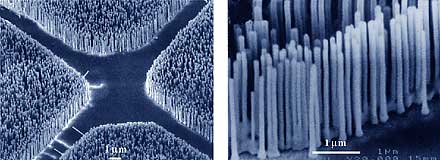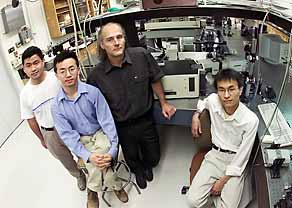|
One of the smallest lasers ever made -- far too small
to be seen even with the aid of the most powerful optical
microscope -- has been successfully tested by a team of
researchers with Lawrence Berkeley National Laboratory
(Berkeley Lab) and the University of California at Berkeley.
This device, which emits flashes of ultraviolet light,
is called a "nanowire nanolaser" and it measures
just under 100 nanometers in diameter or about one ten-millionth
of an inch
The nanowire nanolasers are pure crystals of zinc oxide
that grow vertically in aligned arrays like the bristles
on a brush. These crystal wire "bristles" range
from two to 10 microns in length, depending upon how long
the growth process was allowed to proceed. By comparison,
the tiniest solid-state lasers in use today are fashioned
from thin films of either gallium arsenide or gallium
nitride and generally run several microns thick, or about
one hundred thousandths of an inch. A typical human hair
is about 100 microns thick.

UNDER AN ELECTRON MICROSCOPE, THE ARRAYS OF NANOWIRE
NANOLASERS LOOK LIKE BRISTLES OF A BRUSH, EACH BRISTLE
AN INDIVIDUAL LASER ABOUT ONE THOUSANDTH THE DIAMETER
OF A HUMAN HAIR.
Photo by Peidong Yang/UC
Berkeley, courtesy of Science
"The ability to produce high-density arrays of light-emitting
nanowires would open up lots of possible applications
that today's gallium arsenide devices can't do,"
says Peidong Yang, a chemist with Berkeley Lab’s Materials
Sciences Division and a professor with UC Berkeley’s Chemistry
Department who was the lead scientist on this project.
Collaborating with Yang from Berkeley Lab were Henning
Feick and Eicke Weber, also with the Materials Sciences
Division, and Samuel Mao and Rick Russo of the Energy
and Environmental Technologies Division. Joining them
were Michael Huang, Haoquan Yan, Yiying Wu and Hannes
Kind, with the UC Berkeley Chemistry Department. A paper
reporting this work appeared in the June 8 issue of the
journal Science.
To produce these nanowires, the research team used a
standard crystal-growing technique called epitaxy in which
one crystalline material is grown over the surface of
another. In this case, sapphire crystals, coated in patterns
with a thin film of gold, were plunged into a hot gas
of zinc oxide. The gold film served as a catalyst and
within ten minutes, millions of zinc oxide nanowires formed
over the patterns on the sapphires.
 |

PICTURED (LEFT TO RIGHT) ARE RESEARCHERS HAOQUAN
YAN, SAMUEL MAO, RICHARD RUSSO. AND PEIDONG YANG
|
Stated the authors in their Science paper, "This
capability of patterned nanowire growth allows us fabricate
nanoscale light emitters on a substrate in a controllable
fashion."
To produce light, the researchers used a process called
"optical pumping." Working at room temperatures,
the zinc oxide nanowires were flashed with light from
a visible light laser. This light excited the zinc oxide
molecules, causing them to emit photons. Cross-sections
of the wires show them to be hexagonal and capped on the
end. This cap is perfectly flat as is the interface between
the wire and the sapphire substrate. These two perfectly
flat surfaces act like mirrors and cause the photons emitted
by the excited zinc oxide molecules to bounce back and
forth between them. This reflected light causes the zinc
oxide molecules to emit even more photons until the light
becomes sufficiently amplified to pass out of the nanowire’s
end cap in a burst of ultraviolet light.
Whether the process proves to be a scientific curiosity
or a first step towards the development of a significant
new technology may hinge on the Berkeley Lab researchers
finding a way to extract light from their nanowires via
electrical pumping. This would entail the use of electrodes
attached to both ends of the nanowires and stimulating
photon emissions inside the wires with electrons. Electrical
pumping is required for the nanowires to be integrated
into an electronic circuit. If it can be done, it could
open up a broad range of potential applications including
photonics, the use of light for superfast data processing
and transmission, and the so-called "lab on a chip,"
a microchip equipped with nano-sized light sources and
sensors to perform instant and detailed analyses for chemistry,
biology, and medical studies.
"With something this small, people will think of
new applications for it," says Russo.
This research was supported by funds from the Chemical
Sciences Division and the Materials Science Division of
the Office of Basic Energy Sciences in the U.S. Department
of Energy; UC Berkeley; the Camille and Henry Dreyfus
Foundation; the 3M Corporation; and the National Science
Foundation.
|


